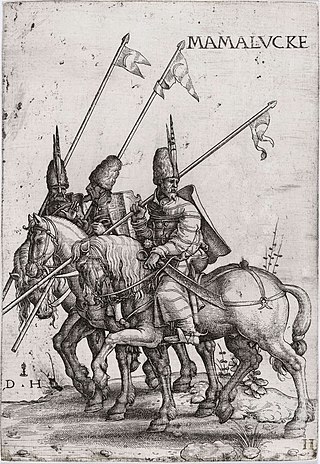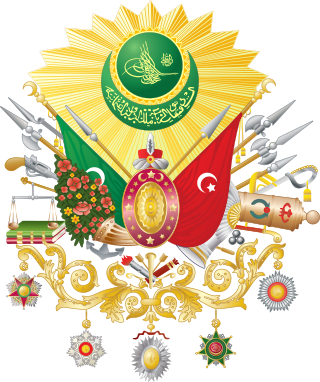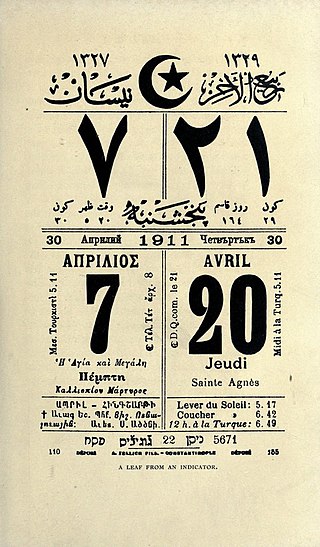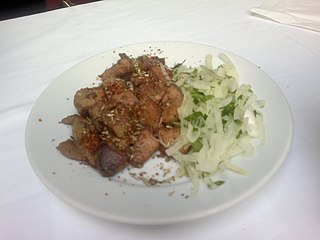Related Research Articles

The Ottoman Empire, historically and colloquially known as the Turkish Empire, was an empire that controlled much of Southeast Europe, West Asia, and North Africa between the 14th and early 20th centuries. The empire also controlled parts of southeastern Central Europe from the early 16th to the early 18th century.

The Armenian genocide was the systematic destruction of the Armenian people and identity in the Ottoman Empire during World War I. Spearheaded by the ruling Committee of Union and Progress (CUP), it was implemented primarily through the mass murder of around one million Armenians during death marches to the Syrian Desert and the forced Islamization of others, primarily women and children.

Mamluk were non-Arab, ethnically diverse enslaved mercenaries, slave-soldiers, and freed slaves who were assigned high-ranking military and administrative duties, serving the ruling Arab and Ottoman dynasties in the Muslim world.

The Ottoman dynasty consisted of the members of the imperial House of Osman, also known as the Ottomans. According to Ottoman tradition, the family originated from the Kayı tribe branch of the Oghuz Turks, under Osman I in northwestern Anatolia in the district of Bilecik, Söğüt. The Ottoman dynasty, named after Osman I, ruled the Ottoman Empire from c. 1299 to 1922.

Marmon Motor Car Company was an American automobile manufacturer founded by Howard Carpenter Marmon and owned by Nordyke Marmon & Company of Indianapolis, Indiana, US. It produced luxury automobiles from 1902 to 1933.

Ottoman Turkish was the standardized register of the Turkish language used by the citizens of the Ottoman Empire. It borrowed extensively, in all aspects, from Arabic and Persian, and its speakers used the Ottoman Turkish alphabet for written communication. During the peak of Ottoman power, words of foreign origin in Turkish literature in the Ottoman Empire heavily outnumbered native Turkish words, with Arabic and Persian vocabulary accounting for up to 88% of the Ottoman vocabulary in some texts.

Van Province is a province and metropolitan municipality in the Eastern Anatolian region of Turkey, between Lake Van and the Iranian border. Its area is 20,921 km2, and its population is 1,128,749 (2022). Its adjacent provinces are Bitlis to the west, Siirt to the southwest, Şırnak and Hakkâri to the south, and Ağrı to the north. The capital of the province is the city of Van, with a population of 525,016 at the end of 2022. The second-largest city is Erciş, with 92,945 inhabitants at end 2022. The province is considered part of Western Armenia by Armenians and was part of ancient province of Vaspurakan. The region is considered to be the cradle of Armenian civilization. Before the Armenian genocide, Van Province was part of six Armenian vilayets. A majority of the province's modern day population is Kuresunni Azerbaijanis and Kurdish.

Hakkâri Province, is a province in the southeast of Turkey. The administrative centre is the city of Hakkâri. Its area is 7,095 km2, and its population is 275,333 (2022). The current Governor is Ali Çelik. The province encompasses 8 municipalities, 140 villages and 313 hamlets.

Turkish people or Turks are the largest Turkic people who speak various dialects of the Turkish language and form a majority in Turkey and Northern Cyprus. In addition, centuries-old ethnic Turkish communities still live across other former territories of the Ottoman Empire. Article 66 of the Turkish Constitution defines a "Turk" as: "Anyone who is bound to the Turkish state through the bond of citizenship." While the legal use of the term "Turkish" as it pertains to a citizen of Turkey is different from the term's ethnic definition, the majority of the Turkish population are of Turkish ethnicity. The vast majority of Turks are Muslims and follow the Sunni and Alevi faith.

The Battle of Khresili was fought on December 14, 1757, between the armies of the Kingdom of Imereti and the Ottoman Empire. King Solomon I of Imereti established a strong monarchy and unified western Georgia. His actions strained the relations between him and the Ottoman Empire. The Ottomans, in particular, sought to stop Solomon's struggle against slavery. They were in an alliance with rebellious Georgian nobles who opposed their monarch. One of them was Levan Abashidze, who lead an Ottoman army to the Kingdom of Imereti. Solomon enticed his enemies into a strategically adroit place near Khresili where his forces would gather to engage them.

Niğde is a city and the capital of in the Central Anatolia region of Turkey. It is the seat of Niğde Province and Niğde District. Its population is 170,511 (2022). It lies at an elevation of 1,276 m (4,186 ft).

The Marmon-Herrington Armoured Car was a series of armoured vehicles that were produced in South Africa and adopted by the British Army during the Second World War. RAF Armoured Car companies possessed them, but seem never to have used them in action, making greater use of Rolls-Royce Armoured Cars and other types.

Turkey, officially the Republic of Türkiye, is a country mainly on the Anatolian Peninsula in West Asia, with a smaller part called East Thrace on the Balkan Peninsula in Southeast Europe. It borders the Black Sea to the north; Georgia to the northeast; Armenia, Azerbaijan, and Iran to the east; Iraq to the southeast; Syria and the Mediterranean Sea to the south; the Aegean Sea to the west; and Greece and Bulgaria to the northwest. Cyprus is off the south coast. Most of the country's citizens are ethnic Turks, while Kurds are the largest ethnic minority. Ankara is Turkey's capital and second-largest city, while Istanbul is its largest city and economic and financial centre, as well as the largest city in Europe.
Kemankeş Kara Ali Paşa was a Turkish Ottoman statesman. He was the 80th grand vizier of the Ottoman Empire from 1623 to 1624. during the reign of Sultan Murad IV. He played an crucial role in the Ottoman–Safavid War (1623–39). He was highly influential especially with the Janesaries.
Hadım Mehmed Pasha was a Georgian Ottoman statesman. He was Grand Vizier of the Ottoman Empire between 21 September 1622 and 5 February 1623. He also served as the Ottoman governor of Egypt from 1604 to 1605.

The Turks in Algeria, also commonly referred to as Algerian Turks, Algerian-TurkishAlgero-Turkish and Turkish-Algerians were the ethnic Turkish and renegades who emigrated to Algeria during the Ottoman period. A significant number of Turks intermarried with the native population, and the male offspring of these marriages were referred to as Kouloughlis due to their mixed Turkish and central Maghrebi heritage. However, in general, intermarriage was discouraged, in order to preserve the "Turkishness" of the community. Consequently, the terms "Turks" and "Kouloughlis" have traditionally been used to distinguish between those of full and partial Turkish ancestry.

The language of the court and government of the Ottoman Empire was Ottoman Turkish, but many other languages were in contemporary use in parts of the empire. The Ottomans had three influential languages, known as "Alsina-i Thalātha", that were common to Ottoman readers: Ottoman Turkish, Arabic and Persian. Turkish was spoken by the majority of the people in Anatolia and by the majority of Muslims of the Balkans except in Albania, Bosnia, and various Aegean Sea islands; Persian was initially a literary and high-court language used by the educated in the Ottoman Empire before being displaced by Ottoman Turkish; and Arabic, which was the legal and religious language of the empire, was also spoken regionally, mainly in Arabia, North Africa, Mesopotamia and the Levant.

Aziziye Mosque or is an Ottoman mosque in Konya, Turkey. It is well known for the columned balcony of its minaret, an architectural feature rarely seen in Turkish mosques.

Arnavut ciğeri is a Turkish dish made of oil-fried lamb or veal liver cubes seasoned with hot pepper, served traditionally with onion and parsley.
References
- ↑ Marmon, Shaun Elizabeth; Marmon, Assistant Professor of Religion Shaun (1995). Eunuchs and Sacred Boundaries in Islamic Society. Oxford University Press. p. 32. ISBN 978-0-19-507101-6.
